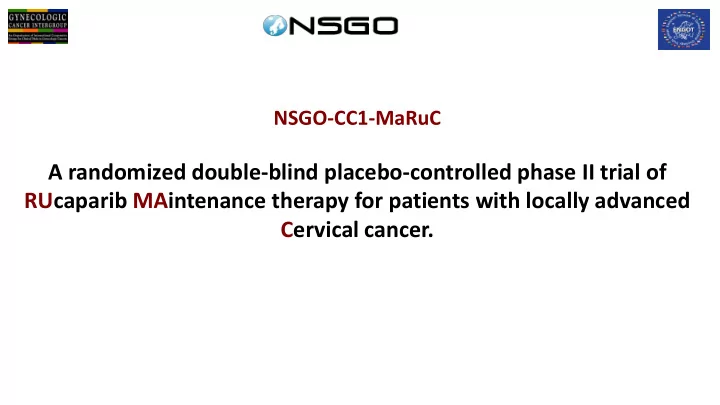

NSGO-CC1-MaRuC A randomized double-blind placebo-controlled phase II trial of RUcaparib MAintenance therapy for patients with locally advanced Cervical cancer.
NSGO-CC1 / MaRuC A randomized double-blind placebo-controlled phase II trial of RU caparib MA intenance therapy for patients with locally advanced C ervical cancer. Cervical cancer Arm A Chemoradiation Definitive Rucaparib 600mg BID for 24 months Squamous, Patient in PR or Adenosquamous, CR adenocarcinoma Arm B Placebo 600mg BID for 24 months Stage 3 & 4 Stratification factors • Histology (squamous vs adenosquamous, adenocarcinoma) n = 162 • FIGO stage (3 vs 4) Randomization: 2:1 • Residual disease vs no residual disease Enrolment of patients with squamous cell histology will be capped once 50% patients with this histo-type are enrolled Sponsor NSGO
Rationale • DNA repair in cervical cancer is less established • HPV infection and oncoviral proteins E6 & E7 causes inactivation of p53 & pRB tumour- suppressor genes leading to cell cycle dysfunction and impaired DNA repair • Cells are therefore increasingly dependent on residual repair pathways • A correlation between response to DNA repair pathways has been noted in the clinic: – Patients treated with chemoradiation have high expression of the nucleotide excision repair protein ERCC1 associated with decreased PFS & OS & activation of the BRCA pathway correlated with treatment failure – Impaired NHEJ repair was related to increased OS • Early phase trials incorporating modulators of DNA repair such as PARP inhibitors are underway Duensing S et al. Cancer Res. 2002; 62:7075 – 7082 Balacescu O et al. BMC Cancer 2014; 14:246 NCT01281852
Design • This is a multicenter, phase 2, doubleblind, placebo-controlled trial of maintenance Rucaparib to obtain preliminary but not conclusive evidence of efficacy of rucaparib in locally advance cervical cancer: • Randomization: 2:1 • Patients are stratified according to: – Histology (squamous vs adenosquamous, adenocarcinoma) – FIGO stage (3 vs 4) – Residual disease vs no residual disease • Squamous cell carcinoma patients will be capped to 50% of patient population
Study arms • Arm A: rucaparib 600mg BID for 24 months • Arm B: placebo BID for 24 months
Study population • Histologically confirmed squamous cell, adenocarcinoma or adenosquamous carcinoma of the cervix. • Subject must have completed definitive chemoradiation for curative intend and is evaluated to be in partial or complete remission post chemoradiation • Initial FIGO stage IIIA, IIIB, IVA (biopsy proven); or any stage with para-aortic metastases. • Toxicities resulting from chemoradiation must resolve to ≤Grade 1 prior to randomization.
Study Statistics • The study is designed to detect a difference in PFS at 24 months corresponding to a hazard ratio of 0.66 (PFS at 24 months to be increased from 46% to 60%) with a power of 80%; one-sided alpha of 15%; • The randomization is 2:1 (2 rucaparib; 1 placebo). • The number of needed events is 83 corresponding to 144 patients. • With an expected dropout rate of 10%, and matching the randomization ratio, we shall recruit a total of 162 patients (108 patients in the rucaparib arm, and 54 patients in the placebo arm) within 18 months. • PFS data should be mature after a minimum follow-up of 24 months.
NSGO-CC1 / MaRuC A randomized double-blind placebo-controlled phase II trial of RU caparib MA intenance therapy for patients with locally advanced C ervical cancer. Cervical cancer Arm A Chemoradiation Definitive Rucaparib 600mg BID for 24 months Squamous, Patient in PR or Adenosquamous, CR adenocarcinoma Arm B Placebo 600mg BID for 24 months Stage 3 & 4 Stratification factors • Histology (squamous vs adenosquamous, adenocarcinoma) n = 162 • FIGO stage (3 vs 4) Randomization: 2:1 • Residual disease vs no residual disease Enrolment of patients with squamous cell histology will be capped once 50% patients with this histo-type are enrolled
Recommend
More recommend